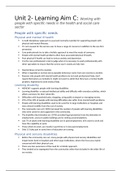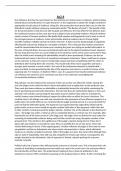1. The two major dysfunctions in cancer development. What are they? (Lewis 235-236)
1.- Defective Cell Proliferation (Growth) -Grow on top of one another and on top/between normal cells.
b.- Defective Cell Differentiation
Divide indiscriminately, divide haphazardly, and can produce greater than 2 cells during mitosis.
A) Protooncogenes: Are genes that promote growth. Any mutations with protooncogenes will lead turn them into oncogenes which will be cancer cells.
B) Tumor suppressor genes : Suppresses growth of tumor cells. Stops division of mutated cells.
o Ex: BRCA-1 and BRCA-2 which increase the risk of breast/ovarian cancer.
2. What is a stem cell? p.188
Are unspecialized cells in the body that have the ability to 1. Remain in their unspecialized state and divide or 2. Differentiate and develop into specialized cells such as a brain cell or a muscle cell Stem cells can be divided into two types: embryonic and adult Embryonic cells come from the embryo at a very early stage in development and have the ability to become any one of the hundreds 3.Contact Inhibition: (Angela)
a.mechanism for proliferation control in normal cells. Normal cells respect the boundaries of other cells surrounding them (Lewis 10th p.235)
4.The three stages in cancer development: initiation, promotion, progression:
Initiation: changes in genes cause mutation in the DNA sequence by genetic inheritance of acquired from life style.
Promotion: reversible proliferation of the altered cells. Increase in the altered cell increases the likelihood of additional mutations.
Progression : final stage of cancer. characterized by increased
growth rate of the tumor, increased invasiveness, and metastasis.
5. Latent period - the interval between exposure to a carcinogen, toxin, or disease causing organism and development of a consequent disease. e latent period, includes both the initiation and promotion stages in the natural history of cancer. The variation in the length of time that elapses before the cancer becomes clinically evident is associated with the mitotic rate of
the tissue of origin and environmental factors. 6. What are the main sites for cancer metastasis in general? (Lewis 235)
Male Female
Prostate
Lung
Colon/Rectum
Urinary Bladder
Non-Hodgkins Lymphoma
Kidney and Renal Pelvis
Oral cavity and pharynx
LeukemiaBreast
Lung
Colon/Rectum
Uterus
Thyroid
Non-Hodgkins Lymphoma
Melanoma
Pancreas 7. What is TNM staging? Please practice one example
Primary Tumor (T) T0-:No evidence of primary tumor
Tis-:Carcinoma in situ
T1-4:Ascending degrees of increase in tumor size and involvement Tx:Tumor cannot be measured or found
Regional Lymph Nodes (N)
N0: No evidence of disease in lymph nodes N1-4: Ascending degrees of nodal involvement Nx: Regional lymph nodes unable to be assessed clinically Distant Metastases (M) M0: No evidence of distant metastases M1-4: Ascending degrees of metastatic involvement, including distant nodes
Mx: Cannot be determined
8. CEA (Angela)
carcinoembryonic antigen (oncofetal protein); found on the surface of cancer cells derived from the GI tract and from normal cells, from the fetal gut, liver and pancreas. CEA normally disappears during the last 3 months of fetal life. Can be used as tumor markers that may be clinically useful to monitor the effect of therapy and indicate tumor recurrence. (Lewis 10 edition p.240)
9. Alpha- Fetoprotein
Alpha- Fetoprotein is a protein which is produced in the liver of a fetus. During development, it is passed through the placenta into the mother's bloodstream and is the main protein during the first three months of development. AFP can be measured during the second trimester of pregnancy and determines if levels are within normal range. If the
levels are too high or too low, that may be a sign of a birth defect such as a neural tube defect which can result in spina bifida or Down syndrome. It is also a tumor marker and can identify molecules which are higher in the blood if an individual has certain cancers. 10 Malignant tumor vs. Benign Tumor - Benign tumor is not a malignant tumor, which is cancer. It does not invade nearby tissue
or spread to other parts of the body the way malignant tumor can. Benign neoplasms are well differentiated, and malignant neoplasms range from well differentiated to undifferentiated. The ability of malignant tumor cells to invade and metastasize is the major difference between benign and malignant neoplasms.
11. What is the purpose of staging? (Lewis 236)
The cause and development of each type of cancer are likely to be multifactorial. Cancer is usually an orderly process that occurs over time and has several stages. This helps plan treatment and a possible prognosis for the patient based on what stage they are in.
12. What is stage 0,1,2,3,4
Stage 0- This stage describes situ which means that there is no cancer, however there are abnormal cells which are located in the same place that they started and have not spread to any lymph nodes or tissues nearby and they have a chance to become cancer if not properly treated. During this stage, cancer is often highly curable and tumors can be
removed entirely with surgery. Stage 1- This stage is usually a small cancer or tumor which has not grown deeply into tissues and lymph nodes which are found nearby. It is also called early stage cancer. Stage 2 & 3- These two stages indicate larger tumors that have grown more deeply into nearby tissues and spread to lymph nodes but not other body parts. Stage 4- This stage indicates that the cancer has spread to other organs and parts of the body. It is called advanced or metastatic cancer. 13. PET scan: positron emission tomography (p. 243); an imaging test that helps reveal how your tissues and organs are functioning. Can be used to determine how your body responds to
cancer treatment (figure 15-7). *book does not go into detail regarding PET scan for cancer)*. Nuclear tracer substance injected and is taken up by metabolically active cells.(p.603)
14. Biopsy and types of biopsy:
A biopsy is the removal of a tissue sample for pathologic analysis. Different location used in sampling biopsy, it depends on the location and the size of the suspected tumor.
Percutaneous biopsy - performed for tissue that can be safely reached through the skin.
Endoscopic biopsy - used for lung or other intraluminal lesions (esophageal, colon, bladder).
In case of inaccessible site, a surgical procedure (laparotomy, thoracotomy, craniotomy) is necessary to obtain a piece of the tumor tissue.
Other techniques for tumor detection: CT, MRI, ultrasound-guided biopsy, stereotactic
biopsy, fluoroscopic-assisted biopsy) to improve tissue localization.
Size of needles used for biopsy: Fine needle aspirates cells from the mass for cytologic examination. Large-core biopsy delivers actual piece of tissue. Excisional biopsy is a surgical removal of the entire lesion, lymph node, nodule, or mass. 15. Nursing management of a patient who has is undergoing, and has undergone biopsy. BEFORE :Review chart for signed consent form. Withhold food and fluids,usually 4 to 6 hours preprocedure. Assess and record baseline vital signs. Review prothrombin time (PT) and platelet count;administer vitamin K as ordered. Instruct to empty bladder immediately before the biopsy. AFTER: Apply pressure to the biopsy site until bleeding stops. Clean the biopsy site and apply a sterile dressing. Monitor the patient’s vital signs and the biopsy site for signs and symptoms of infection.
16. What are the seven warning signs of cancer? CAUTION
C = Change in bowel or Bladder
A = A sore that doesn’t heal
U = Unusual bleeding or discharge from body orifice
T = Thickening or lump in the breast
I = Indigestion or difficulty swallowing
O = Obvious change in a mole or wart
N = Nagging cough or hoarseness
17. What are the different types of surgery for cancer?
Disadvantages: - oldest form of cancer treatment. - malignant cells travel to other locations making surgical cure possible only when the tumor was localized and small. (see FIG. 16-9). The trend is to use less radical surgeries.
18. What is debulking and why we debulk? (Angela)
-Debulking (cytoreductive procedure) may be used if the tumor cannot be completely removed. When this occurs, as much tumor as possible is removed & the patient is given chemotherapy and/or radiation therapy. This type of surgical procedure can make chemo or radiation therapy more effective since the tumor mass is reduced before treatment is initiated. May also be used to relieve pressure or pain (p. 245) 19. Extravasation and chemotherapy
Extravasation is when a chemotherapy drug leaks outside the vein and either onto or into the skin which causes a reaction to occur. There are two types of drug classifications in chemotherapy which are based on the effect they have on tissues when they extravasate which are irritants and vesicants. 1.Irritants are those that cause temporary damage to tissues when they leak and can cause redness, swelling, itchiness, and discomfort at IV site. 2.Vesicants can cause serious damage to tissues if they leak outside the vein and can cause blistering, peeling, and darkening of skin. 20. Preferred IV sites for chemotherapy? Why?
Major concerns associated with the IV administration of antineoplastic drugs include venous access difficulties, device- or catheter-related infection, and extravasation causing local tissue damage.
Irritants will damage the intima of the vein , causing phlebitis and sclerosis and limiting future peripheral venous access but will not cause tissue damage if infiltrated. Vesicants,may cause severe local tissue breakdown and necrosis. To minimize the associated physical discomfort, emotional distress, and risks of infection and infiltration, IV chemotherapy can be administered by a central venous access device (CVAD). CVADs are placed in large blood vessels and permit frequent, continuous, or intermittent administration of chemotherapy, immunotherapy, and targeted therapy, and other products, thus avoiding multiple venipunctures for vascular access
21. What are the common side effects of chemotherapy and radiation
-Nausea and vomiting -Bone marrow suppression
-Myelosuppression
-Decrease in WBC, RBC, platelet count
-With IV Chemo: Immediate pain, burning, sweling, redness, vesicles on skin, after a few days the
skin will ulcer and necrosis 22. Patient teaching for a patient undergoing radiation
· Dr. will put tattoo markers, make sure patient DOES NOT REMOVE those tattoos cause that’s where Dr. will know where to beam the radiation
· Other areas of the body can be washed with mild soap and water
· Radiation will feel a burning sensation so give them aloe vera for skin care
· Nutrition: avoid spicy, salty, acidic foods
· Teach patient to avoid tight clothes
· Have them wear soft clothing
· Inspect skin for any damage
23. Patient teaching for pt receiving brachytherapy (Angela) Radiation delivery system that means “closed” treatment and consists of implantation or insertion of radioactive materials directly into the tumor or in close proximity to the tumor (glossary p.1663)
Patient Teaching (p. 250)
oAssess patient’s ability to process information
oCustomize teaching to meet patient’s and family’s needs
24. How would you orient a new nurse to take care of a patient receiving internal radiation?
be aware that the patient is emitting radioactivity.
Patients with temporary implants are radioactive only while the source is in place.
In patients with permanent implants the radioactive exposure to others is low, these patients may be discharged with minimal precautions.
Wear a dosimeter
If nurse is pregnant, do not assign patient with internal radiation to them. Will harm the baby
25. Management of Mucositis










